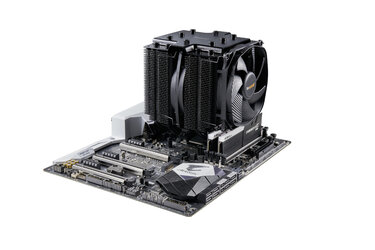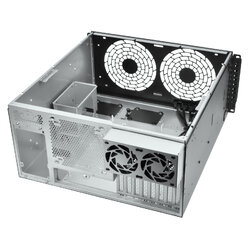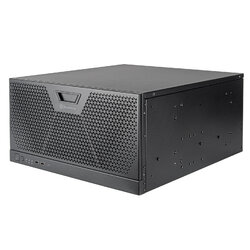tacitus
New Member
- Joined
- May 27, 2023
I want to build a low-noise rack-mounted workstation. My current plan is to use the Silverstone RM51 case (specs and some photos below). I’m looking for guidance on how to optimize this build according to my goals:
— Low noise is a requirement for me because I do audio recording in the room where this computer will be.
— Rack mounting is a long-time dream of mine, in part because I have a lot of rack-mounted audio equipment and it would be awesome to have all of my gear, including my computer, in a single rack.
— I don’t strictly need high end CPU performance, although a strong CPU is nice to have for my audio production work.
— I want this computer to be ready to utilize a high-end GPU at some later point (for training and running AI models, so I would mainly be looking for a card with a lot of memory, e.g. 24 GB or more, not necessarily the fastest GPU).
— I am prepared to throw a bit of money at the case and cooling setup and I would be happy to err on the side of over-sizing the cooling.
The RM51 comes with two 180 mm intake fans pre-installed behind the mesh front panel, so that’s a good start. It has a slot for a 140 mm exhaust fan in the back. It also comes with an external fan cage which can be used to mount an additional two 80 mm fans in the back, above the expansion slots.
The case can fit a CPU cooler up to 181 mm in height and I would be happy to utilize as much as possible of that space and get a high-end cooler, maybe the Be Quiet! Dark Rock Pro 4. AIO water cooling is an option, as the 180 mm front fans can be replaced with a 360 mm AIO radiator. I don't think I am confident enough in my computer building skills to go for a custom water cooling solution.
Here are some question which I have a hard time answering despite many hours of research:
1. If I splurge on a high-end CPU cooler, high-end fans, a PSU engineered for noise reduction etc… How strong a CPU can I get away with and still have the computer be fairly silent with this kind of case? How should I reason about this to come up with an estimate?
2. As far as I understand, air cooling is probably my best bet for noise reduction, because the total number of fans moving air around would be higher and they would thus operate at lower RPM. But my understanding is superficial. Should I consider AIO water cooling to get noise down?
3. If I were confident enough to embark on building a custom loop liquid cooling system, could I get this computer even quieter?
4. Is the RM51 a bad choice? Maybe its thermal and acoustic characteristics are so inferior to e.g. high-end gaming cases, that I should reconsider the whole rack-mounting part? Maybe there are better rack-mounted options?
5. Are the pre-installed 180 mm fans (Air Penetrator 184i PRO) suitable for a silent build? Should I replace them, e.g. with fans engineered specifically for silent operation? Unusual form factor so not sure if there are any plausible alternatives?
6. If I later plug a high-end graphics card into this machine, how will it change the picture? Can I prepare for this scenario by making better choices from the beginning? (The PSU I have picked out so far is 850 W.) Is it unrealistic to have a silent computer with a 24+ GB graphics card in a case like this? Or is it just a matter of paying for a card with particularly good cooling or maybe underclocking the GPU?
Thank you in advance for any comments you may have for me!
Here are some details about (and photos of) the components I currently have my sights on:
— Low noise is a requirement for me because I do audio recording in the room where this computer will be.
— Rack mounting is a long-time dream of mine, in part because I have a lot of rack-mounted audio equipment and it would be awesome to have all of my gear, including my computer, in a single rack.
— I don’t strictly need high end CPU performance, although a strong CPU is nice to have for my audio production work.
— I want this computer to be ready to utilize a high-end GPU at some later point (for training and running AI models, so I would mainly be looking for a card with a lot of memory, e.g. 24 GB or more, not necessarily the fastest GPU).
— I am prepared to throw a bit of money at the case and cooling setup and I would be happy to err on the side of over-sizing the cooling.
The RM51 comes with two 180 mm intake fans pre-installed behind the mesh front panel, so that’s a good start. It has a slot for a 140 mm exhaust fan in the back. It also comes with an external fan cage which can be used to mount an additional two 80 mm fans in the back, above the expansion slots.
The case can fit a CPU cooler up to 181 mm in height and I would be happy to utilize as much as possible of that space and get a high-end cooler, maybe the Be Quiet! Dark Rock Pro 4. AIO water cooling is an option, as the 180 mm front fans can be replaced with a 360 mm AIO radiator. I don't think I am confident enough in my computer building skills to go for a custom water cooling solution.
Here are some question which I have a hard time answering despite many hours of research:
1. If I splurge on a high-end CPU cooler, high-end fans, a PSU engineered for noise reduction etc… How strong a CPU can I get away with and still have the computer be fairly silent with this kind of case? How should I reason about this to come up with an estimate?
2. As far as I understand, air cooling is probably my best bet for noise reduction, because the total number of fans moving air around would be higher and they would thus operate at lower RPM. But my understanding is superficial. Should I consider AIO water cooling to get noise down?
3. If I were confident enough to embark on building a custom loop liquid cooling system, could I get this computer even quieter?
4. Is the RM51 a bad choice? Maybe its thermal and acoustic characteristics are so inferior to e.g. high-end gaming cases, that I should reconsider the whole rack-mounting part? Maybe there are better rack-mounted options?
5. Are the pre-installed 180 mm fans (Air Penetrator 184i PRO) suitable for a silent build? Should I replace them, e.g. with fans engineered specifically for silent operation? Unusual form factor so not sure if there are any plausible alternatives?
6. If I later plug a high-end graphics card into this machine, how will it change the picture? Can I prepare for this scenario by making better choices from the beginning? (The PSU I have picked out so far is 850 W.) Is it unrealistic to have a silent computer with a 24+ GB graphics card in a case like this? Or is it just a matter of paying for a card with particularly good cooling or maybe underclocking the GPU?
Thank you in advance for any comments you may have for me!
Here are some details about (and photos of) the components I currently have my sights on:
2 x 180 mm intake fans, pre-installed: Air Penetrator 184i PRO
0-1200 RPM
0-143.21 CFM
0-34.5 dBA
140 mm exhaust fan: Be Quiet! Silent Wings Pro 4 140mm PWM
0-2400 RPM
0-97.41 CFM
0-36.8 dBA
CPU cooler: Be Quiet! Dark Rock Pro 4
TDP: 250 W
dBA @ 50/75/100%: 12.8 / 17.9 / 24.3
Dual-tower design, 2 fans, both Silent Wings PWM, one 120 mm and one 135 mm

PSU: Be Quiet! Straight Power 11 850 W Gold
Case: Silverstone RM51


0-1200 RPM
0-143.21 CFM
0-34.5 dBA
140 mm exhaust fan: Be Quiet! Silent Wings Pro 4 140mm PWM
0-2400 RPM
0-97.41 CFM
0-36.8 dBA
CPU cooler: Be Quiet! Dark Rock Pro 4
TDP: 250 W
dBA @ 50/75/100%: 12.8 / 17.9 / 24.3
Dual-tower design, 2 fans, both Silent Wings PWM, one 120 mm and one 135 mm

PSU: Be Quiet! Straight Power 11 850 W Gold
Case: Silverstone RM51

